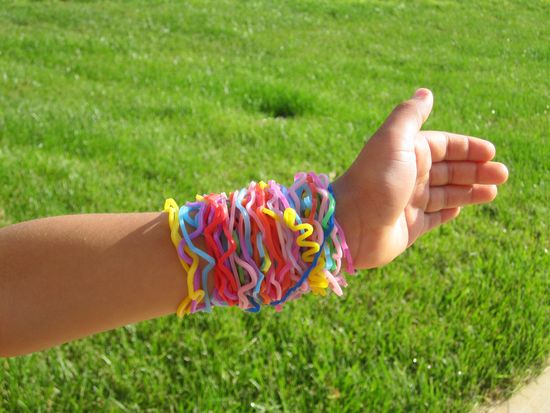UPDATE 06/15/10 – Listen to my radio interview on NPR's All Things Considered about the Silly Bandz fad.
They are for boys or girls, you wear them on your wrist or elsewhere and just about every kid has to have an arm full of them, prompting many schools to ban them. Welcome to the world of Silly Bandz. Like most toy sensations to hit the market, there are no shortage of gushing morning shows, and idolatry newspaper articles declaring the little silicone/rubber bands in various shapes the must have kids toy of the moment. Stores sell out in hours and brands are getting in on the action by creating licensed versions of these bands. Though this probably fits the textbook definition of what any marketer would call a fad – it does stand apart from many other toy fads for a few key reasons that might just make this one of the most interesting product marketing examples to come along in several years. Before you dismiss this as just another blog post jumping on the bandwagon (um, pun intended), here are a few reasons I think this fad may be worth a deeper look:
-
Collectible, tradeable, visible and talkable. Just like the Olympic pins phenomenon that happens every four years, the bands not only have an appeal as something visible that you can wear – but also are being shared and traded as a kind of social currency. Get a band that no one else has, and you have something worth trading and talking about. It's a part of many trends, but an important reason that a product catches on.
- Almost anyone can make them and sell them. While Silly Bandz claims to be the original maker of these bands with the trademark to prove it, there are plenty of other makers of these bands who are actively promoting their own offering. With a simple idea like this, the barriers to manufacturing and marketing are so low that anyone can make them and sell them – almost overnight. Not to mention that the margins should be great as these bands can't cost much to produce. This means that the benefit of the trend goes beyond one lucky company – and spreads out to others in the market.
- They help drive people to retail stores. Any product that can get people to go into a store more frequently is like a gold mine for most retailers, and these bands have the added benefit of generally selling for between $3 for a pack of 12 to $5 for a pack of 24 – which means most consumers will have some money left over for other incidental purchases. Not to say that the bands can single handedly help turn around retail sales that have generally been shrinking, but according to some reports, these bands are the #1 selling product in America, so if any one product could do it, this would be it.
- Lack of marketing is (and has been) a benefit. Though it may not be what many marketers want to hear, there are some products that manage to become popular without significant marketing efforts behind them. Every report on these bands talks about how they have been steadily growing in popularity organically through word of mouth. Some evidence of how this has been happening is traceable online – before all the recent hype, a comment on an Amazon listing for one of these packs from a mom talks about how this was the hottest product in her daughter's fourth grade class back in February of this year. While the product is getting media attention now, it's growth was through the passion of elementary school kids who first discovered it and spread it around.
What do all of these points add up to? These bands may last no longer than most other product fads, but the lessons from their rise to popularity are ones that we can all learn something from.








WE RECENTLY REMOVED COMMENTING - LEARN WHY HERE >